William Mullen
Chicago Tribune
Wed, 01 Sep 2010 17:46 CDT
A meteorite that lit up the night sky over the upper Midwest as it plummeted into southeastern Wisconsin on April 14 now has a name: Mifflin, for rural Mifflin Township where it fell.
Tens of thousands of eyewitnesses in Wisconsin, Minnesota, Iowa
and Illinois saw the meteor as it streaked down to Earth shortly after
10 p.m., setting hundreds of professional and amateur meteorite hunters
scrambling over farm fields for several weeks afterward in search of
pieces of the alien rock.
Terry Boudreaux, a private Lake Forest
meteorite hunter and collector, located some of the first recovered
pieces of the meteorite found by farmers in the township. He donated
four specimens to the Field Museum
from pieces of the meteorite he subsequently obtained. The museum also
has two specimens on loan from meteorite hunter Michael Farmer, all now
on display.
One of the Field specimens was analyzed by the museum's meteorite curator, Philipp Heck, and by Andrew Davis at the University of Chicago and Noriko Kita at the University of Wisconsin in Madison.
Heck said they found it is a common L5 chondrite meteorite, a fragment
of an asteroid shattered in a collision 470 million years ago in the
asteroid belt between Mars and Jupiter, orbiting the sun until it came
to Earth.
Casey Kazan
The Daily Galaxy
Wed, 01 Sep 2010 14:39 CDT
New evidence has been discovered that reinforces the panspermia
thoery that the red rain which fell in India in 2001, contained cells
unlike any found on Earth. Panspermia is the idea championed by
physicist Fred Hoyle that life exists throughout the universe in comets,
asteroids and interstellar dust clouds and that life of Earth was
seeded from one or more of these sources.
In 1903, in the German journal Umschau, Svante Arrhenius
removed the meteors from the equation. Instead, he wrote, individual
spores wafted throughout space, colonizing any hospitable planet they
lit on. Arrhenius named the theory panspermia.
A growing body of evidence suggests that it might be Hoyle and Arrhenius might have been correct.
For example, various insects such as have been shown to survive for
months or even years in the harsh conditions of space. the Allen Hills
Mars meteorite that some scientists believe holds evidence of life on
Mars, is that its interior never rose above 50 degrees centigrade,
despite being blasted from the Martian surface by an meteor impact and
surviving a fiery a descent through Earth's opaque atmosphere.
"Spores," says Gerda Horneck, of DLR German Aerospace Center in Köln,
"can withstand a variety of different hostile conditions: heat,
radiation, desiccation, chemical substances, such as alcohol, acetone
and others. They have an extremely long shelf life. This is because the
sensitive material, the DNA, is especially packed and protected in the
spores
In 2001, the inhabitants of Kerala in the southern India observed red
rain falling during a two month period. One, Godfrey Louis, a physicist
at nearby Cochin University of Science and Technology, intrigued by this
phenomena, collected numerous samples of red rain to find out what was
causing the contamination, perhaps sand or dust from some distant
desert.
Examining the red rain under a microscope he found that the
rain water was filled with red cells that look remarkably like
conventional bugs on Earth. What was strange was that Louis found no
evidence of DNA in these cells which would rule out most kinds of known
biological cells (red blood cells are one possibility but ought to be
destroyed quickly by rain water).
Louis published his results in the peer-reviewed journal Astrophysics and Space
in 2006, along with the tentative suggestion that the cells could be
extraterrestrial, perhaps from a comet that had disintegrated in the
upper atmosphere and then seeded clouds as the cells floated down to
Earth as well as reports in the region of a sonic boom-type noise, which
could have been caused by the entry of an object in the upper
atmosphere.
Since his initial discovery, Louis has intensified his study the cells
with an international team including Chandra Wickramasinghe from the
University of Cardiff in the UK and one of the leading proponents of the
panspermia theory, which he developed in the latter half of the 20th
century with the Fred Hoyle.
The team's new research show that the cells reproduce at a temperature
of 121 degrees C. "Under these conditions daughter cells appear within
the original mother cells and the number of cells in the samples
increases with length of exposure to 121 degrees C," they report. By
contrast, the cells are inert at room temperature. The spores of some
extremophiles can survive these kinds of temperatures and then reproduce
at lower temperatures but nothing discovered to date on Earth behaves
like this at these temperatures -an extraordinary claim that will need
to be independently verified before it will be more broadly accepted.
Wickramasinghe's team say they've examined the way these fluoresce when
bombarded with light and say it is remarkably similar to various
unexplained emission spectra seen in various parts of the galaxy. One
such place is the Red Rectangle (image above), a cloud of dust and gas
around a young star in the Monocerous constellation.
Source:
Ref: arxiv.org/abs/1008.4960: Growth And Replication Of Red Rain Cells At 121oC And Their Red Fluorescence
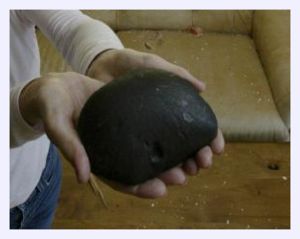
Valuable: The meteorite, which astronomers believe fell here, would look smooth and black.
The hunt is on for a meteorite that could be worth more than its weight in gold.
A fireball blazed across the night sky on Wednesday, leading astronomy experts to believe it came down somewhere here.
Astronomy Ireland chairman David Moore said the discovery of a meteorite
would be very rare -- only three meteorites have been found in Ireland
in the past 200 years.
A meteorite was last found in Ireland in 1999 when a Carlow woman found a
handful of shattered meteorite pieces on a country lane near Leighlin
Bridge.
The collector who bought the fragments valued them at €100,000.
Jammed
Astronomy Ireland says its switchboard has been jammed with calls from
members of the public who had witnessed the meteor shower.
It says it should be able to pinpoint its general location within a week.
"The meteorite will stand out because it has a burnt, smooth exterior," Mr Moore said.
"People can pick it up. There is no kryptonite or any crazy substance that would poison or radiate a person."
The group is urging those who saw the latest shower to visit this website and fill in a Fireball Report Form to allow experts trace its path and identify possible landing sites.
A Monroe man thought his house came "under fire" but instead found
what he believed to be a small meteorite stuck to the side of his house.
We checked with the experts to find out what the likelihood is of a
meteorite falling to earth and wedging itself into Greg Weller's home.
Weller said he noticed the dark charcoal substance for the first time on
Saturday while he was gardening. "It looked like the brick just broke
off, and there was something dark underneath it."
The night before, Weller says he'd heard what he thought were gunshots
outside. Once he noticed the substance he started digging around, and
began to suspect something a little more "out of this world."
"I looked up some stuff about meteorites and found a magnet and stuck it
to it... And they said that's a test right there. And the more I read,
the more I was sure it was a meteorite."
We decided to take his suspicions -- and pictures of what we
found at his house -- to the University of Washington's Astronomy
department.
Toby Smith says without having the rock "in hand" he can't know for sure.
"People bring in meteorites about once a month to me for 20 years,and
none of them have been a meteorite yet." He doesn't believe this is one
either.
"They are usually slag, which is formed in many different environments..
It's part of the iron ore process.. It looks strange and it attracts
magnets.. So that's why people generally bring it in and I think 9 out
of 10 are pieces of slag.. the rest of them are usually pieces of iron
ore."
We broke the news to Weller, and he still wants to know where it came
from. Our astronomer admits there's no logical explanation for how the
dark charcoal substance got there. So with the ever so slight
possibility it could still be a meteorite from outer space... Weller is
shooting for a second opinion.
Colombian
authorities confirmed that a "giant fireball" that fell from the sky in
the Santander department, central Colombia, was a meteorite.
The Colombian media has been buzzing with eye witness accounts of the
fireball, which caused a massive explosion at 3:15PM local time Sunday.
Andina.com reported
that Bucaramanga Mayor Fernando Vargas confirmed that the phenomenon
was a meteorite that left a crater 100 meters in diameter when it
crashed into the earth in the San Joaquin municipality in Santander.
Colombian air force helicopters were commissioned to fly over the area to try to locate the source of the explosion.
The director of the University of Nariño's Astronomic Observatory, Alberto Quijano, told RCN Radio Sunday that he believed the object was a meteorite.
In rural areas of Santander, police received reports that the explosion had shattered windows in the area.
New
Deal - Discovering something out of this world was something the
Smith family thought was only possible in movies and TV shows.
No burning rocks came crashing from the sky in this case - instead,
Todd Smith happened to spot an odd-looking rock while he was mowing his
front yard in June. The rock was partially buried in the ground near the
gas meter, located a few feet from the roadway.
At first, he kept mowing, but since Todd and his family had seen the
"Meteorite Men" TV show on the Science Channel, he said, he decided to
go back and pick up the rock. As soon as he held it in his hand, he
noticed it was not a typical rock.
"The weight of it was just wrong. That was the first thing that stood
out to me," Todd said. "It crossed my mind that it could be (a
meteorite) based on how it looked and all and how heavy it was. I
thought it was probably a piece of iron."
He showed the rock to his 12-year-old son, Payton, and told him
to find tests online to determine if the golf ball-size rock was a
meteorite. Roughly 30 minutes later, Payton believed they did have their
very own piece of a meteor after using tests he found on the Internet,
such as checking the rock magnetism and slicing the rock open.
"I looked at it and thought: think of the odds. How could it be a meteorite here on the front yard?" Payton said.
Even Todd's wife, Lena, expressed her surprise at her husband's
remarkable find and ability to differentiate a meteorite from other
rocks. But she soon discovered it was no ordinary rock when Todd cut it
open and revealed what she said looked like "chrome pieces" sparkling
inside the meteorite's core.
On Aug. 25, the Smiths learned their unusual rock was an official
meteorite, according to Alan Rubin of the Institute of Geophysics and
Planetary Physics at the University of California in Los Angeles.
After conducting their home tests, Todd sent about 20 e-mails to
meteorite experts nationwide and received a response from Rubin, who
would analyze the rock immediately in his lab.
The meteorite was officially named the "New Deal Meteorite" and
classified as an H6 ordinary chondrite - one of 3,889 approved
meteorites with that classification, according to the U.S. Geological
Society Meteoritical Bulletin Database.
The meteorite probably fell a long time ago, Todd said, based on how weathered it was.
Todd also enlisted the help of Anne Black, vice president of the
International Meteorite Collectors Association, to get the meteorite
sliced into pieces for his family and for the New Deal ISD science
department. He said the slices are still being cut and polished, but
they should be ready by next week.
Since it was found in New Deal, Todd said he wanted the school to have
its very own piece. Payton said his classmates and teachers are already
eager to see the famous rock brought to their school.
The rest of the meteorite will be sold to Texas Christian University
through Black and be displayed in its Oscar E. Monnig Meteorite Gallery.
Arthur Ehlmann, former curator of the Monnig gallery and emeritus
professor of geology at TCU, said H6 is one of the less common of the
ordinary chondrites - that classification is based on the meteorite's
chemical composition and texture.
Although the Texas High Plains has produced many meteorites in the past
in Plainview and Lubbock, Ehlmann said the New Deal Meteorite was
"uniquely different" from the others in the region.
The Lubbock Meteorite, an L5 classification, was found in 1938.
The New Deal Meteorite will be displayed in the recent acquisitions
exhibit at the Monnig gallery, which boasts a collection of 1,640
meteorites from around the world.
Since that day in June, Payton still walks around his front yard when he gets home from school, searching for another meteorite.
Todd was not so sure there would be another piece so close to the other, but at this point, they know anything is possible.
"It's one of 297 (meteorites) in Texas, so they're pretty rare to find,"
Todd said. "I mean, it really is; it's just not normal."
Latin American Herald Tribune
Tue, 07 Sep 2010 22:04 CDT
Bogota - Authorities are investigating whether a second explosion
heard on Monday in the vast area of the southwestern Colombian province
of Valle, similar to one heard a day earlier in the northeast, was
caused by a falling meteorite.
The explosion was heard in the municipalities of El Cairo, Versalles Toro and El Dovio, in the northern part of Valle del Cauca.
A powerful explosion was heard and then "the earth seemed to shake," the
area police commander, Col. Nelson Aceros, told reporters.
He recommended that people near the place of impact take precautions.
The emergency response network in Valle was activated to try and
establish the origin of the phenomenon and the consequences, though the
authorities have reported no damages.
Local residents are alarmed, and apparently people "after seeing the
bright light heard an incredibly powerful explosion that shook the
earth," Versalles Mayor Jorge Hernan Gomez said, citing eyewitness
accounts.
At first "we thought that it was an airplane that crashed, but that idea was dismissed," the mayor said.
Since Sunday, meanwhile, Colombian authorities have been investigating
whether an enormous celestial fireball that crossed the sky above
several municipalities in the northeastern province of Santander over
the weekend was a meteorite.
After checking with aviation authorities and the Colombian National
Seismology Network, or RNSC, the possibilities that it was an airplane
in an emergency situation or an eruption from a geological fault in the
area have been discarded, Interior Ministry risk investigations chief
Luz Amanda Pulido said.
Police said they had reports from homes in the rural area near the town
of Piedecuesta of windows shattered by the shock wave from the blast.
Melissa Martin
Winnipeg Free Press
Tue, 07 Sep 2010 01:00 CDT

Photographer Brad Korponay shot this object streaking from east to west across the sky at Steep Rock on Sunday night.
A group of Winnipeg photographers got a long-weekend thrill, when an
unexpected -- and unidentified -- visitor invaded an otherwise perfect
photograph.
Just before 9:30 p.m. Sunday night, Brad Korponay and a couple of
friends were setting up to take some nighttime snaps in Steep Rock,
about 240 kilometres north of Winnipeg, when they saw a stunning object
sailing through the sky.
The bright orange glow flew across the sky from the east, streaking over
Lake Manitoba and descending as it moved westward on a wobbly path.
Then it disappeared behind the clouds. "We thought perhaps it was a
hot-air balloon, as its flickering colour looked like fire," Korponay
said. "It was also moving rather quickly, and the 'flame' burned and
flickered constantly as it moved."
Beyond that guess, Korponay and friends were at a loss to explain the
light that flashed across the sky for under a minute on a calm and
silent night. Even the clouds barely moved during the 273-second photo
exposure. Then, to make things even wilder, a short time later a second,
similar object flew across the sky, this time coming from the north.
The result: one beautiful picture and one big question: Could one local
expert in unidentified flying objects come to the rescue?
This isn't the first curious photo Chris Rutkowski has seen this year.
In fact, the astronomer and internationally recognized expert on UFO
sightings has had a big year: More than 150 flying thingamajigs were
reported in Canada in July and 70 in August. The July number in
particular is "very, very unusual" for the season, Rutkowski said.
Ten per cent of Canadians believe they have seen a UFO, but
only 10 per cent of those witnesses report the sighting, Rutkowski said,
offering kudos to Korponay for reporting the strange object.
But the question remains: What type of object is it?
"It's certainly not a bolide (meteor), because it was seen for too
long," Rutkowski mused, noting that he hasn't seen a UFO report from the
Steep Rock area in a long time. "It doesn't appear to be an aircraft.
If I had to make a guess, it looks like a Chinese lantern. I've seen
something like this before... although what someone would have been
doing with a Chinese lantern out at Steep Rock, I don't know."
The "sky lanterns" are airborne rice-paper lanterns fitted with a candle or waxy fuel cell.
As the candle burns, the hot air inside the lantern lifts it into the sky, where it drifts on the wind.
Finding out whether the guess is accurate, Rutkowski said, would require
interviewing area residents to see if they had released anything into
the sky, and checking whether the glowing object was travelling with or
against the wind.
But what about the chances it was an alien?
"Very close to nil," Rutkowski chuckled.

A color composite image of the June 3rd Jupiter impact flash.
In a paper published today in the Astrophysical Journal Letters,
a group of professional and amateur astronomers announced that Jupiter
is getting hit surprisingly often by small asteroids, lighting up the
giant planet's atmosphere with frequent fireballs.
"Jupiter is a big gravitational vacuum cleaner," says co-author and JPL
astronomer Glenn Orton. "It is clear now that relatively small objects
left over from the formation of the solar system 4.5 billion years ago
still hit Jupiter frequently."
The impacts are bright enough to see through backyard telescopes on
Earth. Indeed, amateur astronomers were the first to detect them,
recording two fireballs in 2010 alone - one on June 3rd and another on
August 20th.
Professional astronomers at NASA and elsewhere have followed up on the
amateur observations, hoping to learn more about the impacting bodies.
According to today's Letter, first-authored by Ricardo Hueso of the
Universidad del País Vasco in Spain, the June 3rd fireball was caused by
an object some 10 meters in diameter. When it hit Jupiter, the impact
released about one thousand million million (10^15) Joules of energy.
For comparison, that's five to ten times less energy than the "Tunguska
event" of 1908, when a meteoroid exploded in Earth's atmosphere and
leveled millions of trees in a remote area of Russia. Scientists
continue to analyze the Aug. 20th fireball, but think it was comparable
in scale to the June 3rd event.
Before
amateurs spotted these fireballs, scientists were unaware collisions so
small could be observed. The first hint of their easy visibility came
in July 2009 when Anthony Wesley, an amateur astronomer from Australia,
discovered a dark spot on Jupiter. It was clearly the swirling debris of
an impact event that he had only just missed. Next time, however, his
luck would improve. On June 3, 2010, he caught a fireball in action.
"I was watching real-time video from my telescope when I saw a
2.5-second-long flash of light near the edge of Jupiter's disk," says
Wesley. "It was clear to me straight away it had to be an event on
Jupiter."
Another amateur astronomer, Christopher Go of the Philippines, confirmed
that the flash also appeared in his recordings. Professional
astronomers, alerted by email, looked for signs of the impact in images
from larger telescopes, including NASA's Hubble Space Telescope, the
European Southern Observatory's Very Large Telescope in Chile, and
Gemini Observatory telescopes in Hawaii and Chile. Scientists saw no
thermal disruptions or typical chemical signatures of debris, which
allowed them to put a limit on the size of the object.
Cameron Venable
Examiner
Fri, 10 Sep 2010 11:49 CDT
The U.S. Coast Guard reports that the crew of the USS Sterett
saw a fireball streak across the sky at around 5 a.m. Friday morning.
Ironically this sighting happened during a time where the marine layer
was not present.
Residents from Mexico to Los Angeles reported the sighting. There are
no photos of the event at the current time, however there are probably
thousands of eyewitnesses.
Early morning rush hour traffic traveling across the area would likely
have seen the event. Since it was viewed from Mexico, San Diego, Orange
County, and Los Angeles.
No marine layer was present at the coast, more reports are sure to come in.
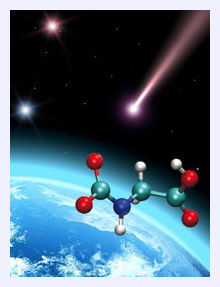
Comet strikes could have delivered the necessary ingredients and conditions to stimulate life on Earth.
The shock waves caused as comets hit the early Earth could have
helped promote the formation of amino acids and the early building
blocks of life, say US researchers.
It is thought that amino acids and short peptides played a significant
role in the chemical evolution that resulted in life on Earth, but
researchers have historically disagreed on how these chemicals got here
in the first place.
Researchers at the Lawrence Livermore National Laboratory and Stanford
University have now run theoretical simulations of shock compressions
that mimic the conditions created when a comet hits the Earth, which
suggest that the ingredients for life on Earth could have been delivered
from space.
Comets are made of dust, ice and compressed gases. The ice is
predominantly water, but is also known to contain small molecules that
promote bacterial growth - prebiotic molecules - such as carbon dioxide,
ammonia and methanol.
Nir Goldman and colleagues studied molecular dynamics
simulations of shock waves after a comet strike to see if the prebiotic
ingredients for life could survive the conditions during and after
impact.
Initially the team thought the conditions after a direct comet strike
would be too intense for the compounds to endure, but they then
considered comets that might have struck the Earth from a gentler angle.
'That would mean that the comet impact would produce much lower
temperatures and pressures and maybe these would be low enough that
something like an amino acid might survive if it was formed,' Goldman
told Chemistry World.
The team also found that the shock waves from a comet's impact can
promote short-lived C-N bonded oligomers, and that when the pressure
dropped after impact, these oligomers break up to form stable complexes
containing the amino acid glycine.
'The computational studies provide some compelling evidence for complex
organic chemistry under conditions of extreme pressure and temperature
such as those expected during oblique impact of a short-period comet
with the early Earth,' says Terence Kee, an astrobiology expert at the
University of Leeds, UK. 'They demonstrate that small organic polymers
are produced under high pressure and temperature which subsequently
break down to form important molecules such as glycine and possibly
higher oligomeric peptides,' he adds.
Goldman now hopes to study the molecular simulations on much longer
timescales to see if they help explain more about prebiotic life on
Earth. 'Longer timescale simulations, both of the shock compression and
the release after the shock compression, could reveal mechanisms for
much more complicated amino acids,' he says.
Reference
N Goldman et al, Nature Chemistry, 2010, DOI: 10.1038/nchem.827
Lin Edwards
PhysOrg
Mon, 13 Sep 2010 00:00 CDT

A photograph of Halley's Comet taken during its 1910 approach.
Researchers
have modeled the likely path taken by Halley's comet in the 5th century
BC and compared their findings to ancient Greek texts from the period.
They now suggest the ancient Greeks saw the comet, which would make the
sightings over two centuries earlier than previous known observations.
Chinese astronomers first described the comet in 240 BC, but in ancient
Greece in 466-467 BC Greek authors described a meteor the size of a
wagon that crashed into the Hellespont region of northern Greece during
daylight hours, frightening the population and creating a tourist
attraction that lasted five centuries. The ancient authors describe a
comet in the sky at the time.
Researchers Daniel Graham, a philosopher, and Eric Hintz, an astronomer,
from Brigham Young University at Provo in Utah, compared their model of
the comet's likely path with the texts describing the meteor crash.
Halley's comet would have been visible for 82 days maximum, depending on
atmospheric conditions at the time, while the ancient texts say the
comet was visible for 75 days.
When the meteor fell, the comet was said to be in the western
sky, and according to the model comet Halley would have been visible
from 4 June to 25 August in 466 BC, and would have been in the western
sky from July 18th. The comet was said to be accompanied by winds and
shooting stars, and in July strong winds are common in the region. If
the model is correct, at this time the Earth would have been moving
under the comet's tail, and shooting stars could have been created from
its debris field.
According to Plutarch, writing in the 1st century AD, Anaxagoras, a
young astronomer, had predicted the meteor crash, but this has puzzled
historians because a meteor collision is a random event difficult to
predict. Graham suggests Anaxagoras probably actually predicted that
rocks might fall from the sky rather than a particular meteorite.
Anaxagoras made the prediction after observing the solar eclipse of 478
BC and concluding that heavenly bodies such as the moon were not lighter
than air, as previously believed, but were actually made of rock. If
nudged out of position, they could therefore crash to earth. It is
possible that Halley's comet could have nudged a small asteroid off
course, and this was the meteor that hit northern Greece, but Dr Hintz
is doubtful and said his feeling is that "it was just a really cool
coincidence."
Halley's comet becomes visible to the unaided eye around every 75-6
years, but calculations of its appearance are difficult because
sometimes its orbits bring it close to planets, whose gravity can change
its course. The comet was named after the English astronomer Edmond
Halley, who in 1705 correctly predicted the 1758 return of a comet that
had previously been observed in 1682. The comet was last seen on 9th
February 1986, and is expected to return in 2061.
More Information:
"An Ancient Greek Sighting of Halley's Comet?" Journal of Cosmology, 2010, Vol 9, 2130-2136. [link]
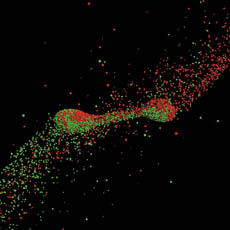
Simulation of a collision between two rubble-pile asteroids, depicted in red and green.
Though
it was once believed that all asteroids are giant pieces of solid rock,
later hypotheses have it that some are actually a collection of small
gravel-sized rocks, held together by gravity. If one of these "rubble
piles" spins fast enough, it's speculated that pieces could separate
from it through centrifugal force and form a second collection ― in
effect, a second asteroid.
Now researchers at Tel Aviv University, in collaboration with an
international group of scientists, have proved the existence of these
theoretical "separated asteroid" pairs.
Ph.D. student David Polishook of Tel Aviv University's Department of
Geophysics and Planetary Sciences and his supervisor Dr. Noah Brosch of
the university's School of Physics and Astronomy say the research has
not only verified a theory, but could have greater implications if an
asteroid passes close to earth. Instead of a solid mountain
colliding with earth's surface, says Dr. Brosch, the planet would be
pelted with the innumerable pebbles and rocks that comprise it, like a
shotgun blast instead of a single cannonball. This knowledge could guide the defensive tactics to be taken if an asteroid were on track to collide with the Earth.
A large part of the research for the study, recently published in the journal Nature,
was done at Tel Aviv University's Wise Observatory, located deep in the
Negev Desert ― the first and only modern astronomical observatory in
the Middle East.
Spinning out in space
According to Dr. Brosch, separated asteroids are composed of small
pebbles glued together by gravitational attraction. Their paths are
affected by the gravitational pull of major planets, but the radiation
of the sun, he says, can also have an immense impact. Once the sun's
light is absorbed by the asteroid, rotation speeds up. When it reaches a
certain speed, a piece will break off to form a separate asteroid.
The phenomenon can be compared to a figure skater on the ice. "The
faster they spin, the harder it is for them to keep their arms close to
their bodies," explains Dr. Brosch.
As a result, asteroid pairs are formed, characterized by the trajectory
of their rotation around the sun. Though they may be millions of miles
apart, the two asteroids share the same orbit. Dr. Brosch says this
demonstrates that they come from the same original asteroid source.
Looking into the light
During the course of the study, Polishook and an international group of
astronomers studied 35 asteroid pairs. Traditionally, measuring bodies
in the solar system involves studying photographic images. But the small
size and extreme distance of the asteroids forced researchers to
measure these pairs in an innovative way.
Instead, researchers measured the light reflected from each member of
the asteroid pairs. The results proved that in each asteroid pair, one
body was formed from the other. The smaller asteroid, he explains, was
always less than forty percent of the size of the bigger asteroid. These
findings fit precisely into a theory developed at the University of
Colorado at Boulder, which concluded that no more than forty percent of
the original asteroid can split off.
With this study, says Dr. Brosch, researchers have been able to prove
the connection between two separate spinning asteroids and demonstrate
the existence of asteroids that exist in paired relationships.
The Montreal Gazette
Sat, 11 Sep 2010 00:00 CDT
Comets are believed by some experts to have wiped out megafauna species
The normally peaceable world of geology is currently alive with a fiery
debate over the theory that deadly space rocks slammed into Northern
Canada about 13,000 years ago, triggering a mini-Ice Age and the
eventual extinction of the woolly mammoth and a host of other
prehistoric species.
That contentious hypothesis - which has prompted a number of studies in
recent years probing sites throughout North America for traces of the
alleged extraterrestrial blast -is under renewed attack after a team of
U.S. and British researchers published a paper last week arguing that
previous claims of impact evidence are demonstrably mistaken.
The new study takes particular aim at several supposed discoveries of
"nanodiamonds" at sites around North America -hailed by advocates of the
impact theory as proof that a cosmic blast sent showers of "shocked"
rock particles across the continent 13,000 years ago.
"The usefulness of cubic nanodiamonds as impact markers in
sediments remains unclear because processes other than impact might
account for them," argues the new study led by Tyrone Daulton, a
physicist at Washington University in St. Louis, and published in the
latest Proceedings of the National Academy of Sciences.
The study also contends that the "nanodiamonds" documented in previous
studies were, in fact, misidentified samples of a carbon-based substance
called graphene that does not provide proof of a meteorite strike. But
one of the researchers whose findings are targeted in the study -
University of Oregon scientist Douglas Kennett - has shot back at
Daulton, calling his work "fundamentally flawed science" that is
unfairly discounting the impact hypothesis.
Woolly mammoths are one of several species of megafauna that some
scientists believe became extinct following a comet-induced mini-Ice
Age.
The controversy is focused on a thin rock layer seen around the world
that represents the boundary of the Younger Dryas -a well-documented,
1,000-year period in Earth's history, characterized by a sudden plunge
in global temperatures beginning about 13,000 years ago.
The Younger Dryas cold spell roughly coincides with the arrival of
humans in North America and with the precipitous decline and eventual
disappearance of populations of mammoths, mastodons, sabre-tooth tigers,
Ice Age horses and other creatures that once roamed the continent.
Some scientists have attributed the Younger Dryas deep-freeze and the
subsequent string of megafauna extinctions to climate change caused by a
massive meltwater outburst into the Atlantic Ocean -probably near
present-day Hudson Bay - as Ice Age glaciers retreated north.
Others have blamed the abrupt loss of so many mammal species on
over-hunting by early big-game hunters whose tribes had recently
migrated to North America from Siberia.
About five years ago, studies began proposing the idea that a comet or
asteroid might have struck a glacial ice dam near Hudson Bay, causing an
initial catastrophe for North American ecosystems and then
kick-starting long-term, global climate changes that wiped out the
mammoths and their contemporaries.
Last year, several U.S. scientists headed by Kennett, unearthed a layer
of what they called "nanodiamonds" on a California island, a find
described at the time as "smoking-gun" proof that a massive comet
triggered the Younger Dryas, killed off the mammoths and threatened the
fragile foothold of North America's earliest human inhabitants.
But Daulton says his team's study disproves the theory because it shows
that no nanodiamonds have been accurately linked to any of the North
American sites.
Nader Heidari
Daily Nexus
Thu, 16 Sep 2010 09:25 CDT

James
Kennett, along with ETH Zurich researcher Gerald Haug, cut into the ice
sheet in Greenland to retrieve samples from the glacial layers. The ice
sheets serve as a striated window into the Earth’s past.
Scientists Brave Icy Environment to Find Evidence of Cosmic Cataclysm
A grueling journey across the ice sheets of Greenland has paid off for a
team of scientists, who have located some diamonds in the rough glacial
climate.
The 21-person team, which included UCSB professor emeritus James Kennett
and his son, University of Oregon geology professor Douglas Kennett,
recently published a paper in the Journal of Glaciology on their discovery of nano-sized diamonds in the ice sheet in a location near the city of Kangerlussuaq.
According to James Kennett, the expedition involved traversing a good
amount of difficult terrain, as the ice sheets of Greenland are
significantly remote.
"The area is cold, remote and [mostly] inaccessible," James Kennett
said. "Looking for a potential layer of diamonds in an ice sheet is like
trying to find a needle in a haystack."
The results provide more evidence for the controversial
hypothesis that a comet struck the Earth approximately 12,900 years
ago, causing massive changes to the climate and resulting in the mass
extinction of approximately 35 mammal species, 19 bird species, and the
human Clovis culture of North America.
The nanodiamonds were found in the Younger Dryas Boundary, or YDB,
layer, which dates to the approximate time of the comet impact and has
been of great interest to Kennett and his team. The Greenland expedition
is a continuation of the team's research, which included a find of the
nanodiamonds in the YDB layer on Santa Rosa Island, providing scientists
with a better look into the state of the planet at the time.
The nanodiamonds were also found with hexagonal diamonds, which have
only been known to form as a result of the intense conditions produced
by a cosmic impact - such as one produced by a comet colliding with
the Earth.
In addition to their findings, the team was the first to locate free diamonds within a glacial ice sheet.
"The most exciting thing that has emerged from this expedition is that
we have discovered free diamonds in glacial ice for the first time on
Earth," Kennett said.
The expedition, which occurred in 2008, was organized by researchers
from the University of Maine. Kennett has recently returned from another
expedition to Greenland in August, and his team is currently processing
the samples collected from the trip to find more evidence of the comet
collision and determine the ecological conditions of the Earth 12,900
years ago.
ScienceDaily
Fri, 17 Sep 2010 00:00 CDT

Breakup
on three pathways. A hydronium ion captures an electron and can then
split into different combinations of fragments. The relative yields of
the three pathways are shown as measured for the heavy hydronium ion
D3O+. The capture produces the unstable radical D3O with the captured
electron in a weakly bound (Rydberg) state.
Comets,
sometimes called "dirty snowballs," are largely composed of water. An
international research team led by Andreas Wolf of the Max-Planck Institute
for Nuclear Physics in Heidelberg, Germany, recently succeeded in
deciphering an important aspect of the way in which water molecules
often form in space. As a surprise, the water molecules produced under
cold, dilute conditions turned out to be produced as particles as hot as
60,000 Kelvin. In their research the physicists, though, did not use a
telescope, but a particle accelerator.
The research appears in the journal Physical Review Letters.
In comets as well as in interstellar clouds, the precursor molecule of
water is the positively charged hydronium ion H3O+. This molecular ion
can be detected from earth by telescopes. In the cosmic clouds
negatively charged electrons are also present, causing frequent
collisions. In those the hydronium ion converts to the neutral instable
radical H3O, which rapidly decays. "For this break-up reaction, nature
offers three choices," describes Andreas Wolf, forming either H2O plus
H, or OH plus H2, or OH plus two H atoms. Present research tries to
determine the yields of these production channels, including that of
water.
Wolf and his colleagues investigated this question by
reproducing the electron attachment in the laboratory. They used the
Heidelberg Test Storage Ring, a racetrack of sorts, with a 55-meter
circumference, on which charged particles race around, guided by
magnets.
It is into this ring that the scientists direct the hydronium ions
which, more precisely, carry heavy hydrogen atoms in order to render
them more suitable for the experiments performed. At one position of the
ring, electrons are admitted in addition, which then proceed together
with the ions over a straight length of almost two meters and then leave
the racetrack again. This happens on each turn, that is several hundred
thousand times per second.
In the electron bath, similar to the process in space, electrons attach
to the hydronium ions, thus forming rapidly decaying neutral molecules.
The fragments from this process do not carry any net electric charge.
Hence, they do not feel the magnetic field keeping the ions on their
circular orbits and rather continue their straight motion. At the place
where they leave the racetrack, Wolf's research team has positioned a
detector that records the impacting fragments. This single-particle
counter has been created in collaboration with colleagues from the
Weizmann Institute of Science in Rehovot, Israel.
In up to one thousand snapshots per second, the detector records the
masses and the momenta of all fragments from individual molecular
breakup reactions. With these data, the molecular dynamics triggered by
the electron attachment and leading to the fragmentation can be
reconstructed exactly.
The first important result: 16.5 per cent of all decays following the
electron attachment lead to the water molecule. "This is quite a high
number," says Wolf. "Electron attachment to hydronium ions can well be
the most important pathway for water production in interstellar clouds
and comets."
Most frequently, with a yield of 71 per cent, the hydronium ions in this
experiment are found to break up into three fragments, namely OH and
two hydrogen atoms (in their heavy-hydrogen equivalents). The
researchers can now understand the reason for this behavior. Its origin
is the large binding energy released by the attachment of the electron.
The entire molecule feels this binding energy and starts a vibration
similar to a spring one stretches and then releases. "To general
surprise we found that the water molecules vibrate with about the
maximum energy which they can possibly support," says Wolf. With this,
each water molecule resulting from the electron capture is close to
rupture: the cause for the three-body fragmentation to become that
frequent.
The high vibrational energy observed can be converted into a temperature. It results in several ten thousand Kelvin: water is created truly hot.
The new evidence has further consequences. On the one hand, it provides
input for computer models which reproduce the complex chemical reaction
network in interstellar clouds. On the other hand, it explains
mysterious signatures found by astronomers in the infrared spectra of
some comets. These signatures indicate the infrared radiation emitted by
hot water molecules during stepwise "de-excitation" of strong
vibrational motion. Not of the least interest are, finally, the detailed
conclusions that can be drawn from the molecular breakup experiments
about the electronic processes in a hydronium ion, which serve as input
for quantum mechanical models of these molecules.
Journal Reference:
H. Buhr, J. Stützel, M. Mendes, O. Novotný, D. Schwalm, M. Berg, D.
Bing, M. Grieser, O. Heber, C. Krantz, S. Menk, S. Novotny, D. Orlov, A.
Petrignani, M. Rappaport, R. Repnow, D. Zajfman, A. Wolf. "Hot Water
Molecules from Dissociative Recombination of D3O+ with Cold Electrons." Physical Review Letters, 2010; 105 (10): 103202 DOI: 10.1103/PhysRevLett.105.103202
PhysOrg
Wed, 22 Sep 2010 11:07 CDT
Scientists
from Boston University's Center for Space Physics reported today that
NASA satellites designed to view the escaping atmosphere of the Sun have
also recorded evidence of escaping gas from the planet Mercury. The
STEREO mission has two satellites placed in the same orbit around the
Sun that the Earth has, but at locations ahead and behind it. This
configuration offers multi-directional views of the electrons and ions
that make up the escaping solar wind. On occasion, the planet Mercury
appears in the field of view of one or both satellites.
In addition to its appearance as a bright disk of reflected sunlight, a
"tail" of emission can be seen in some of the images. Announcing this
new method of observing Mercury and trying to understand the nature of
the gases that might make up this tail feature were the topics presented
at the European Planetary Science Congress meeting in Rome today.
It has been known that Mercury exhibits comet-like features, with a coma
of tenuous gas surrounding the planet and a very long tail extending in
the anti-sunward direction. From Earth, observations of both of these
features can be done using light from sodium gas sputtered off the
surface of Mercury. The Sun's radiation pressure then pushes many of the
sodium atoms in the anti-solar direction creating a tail that extends
many hundreds of times the physical size of Mercury.
"We have observed this extended sodium tail to great distances
using our telescope at the McDonald Observatory in Texas," Boston
University graduate student Carl Schmidt explained, "and now the tail
can also be seen from satellites near Earth." Much closer to Mercury,
several smaller tails composed of other gases, both neutral and ionized,
have been found by NASA's MESSENGER satellite as it flew by Mercury in
its long approach to entering into a stable orbit there.

This
is an image of Mercury's tail obtained from combining a full day of
data from a camera aboard the STEREO-A spacecraft. The reflected
sunlight off the planet's surface results in a type of over-exposure
that causes Mercury to appear much larger than its actual size. The
tail-like structure extending anti-sunward from the planet is visible
over several days and spans an angular size exceeding that of a full
Moon in the night sky.
"What makes the STEREO
detections so interesting is that the brightness levels seem to be too
strong to be from sodium," commented Schmidt, lead author on the paper
presented at EPSC.
Of special interest is the way the tail feature was spotted in the
STEREO data. It was not found by the Boston University team, but by Ian
Musgrave, a medical researcher in Australia who has a strong interest in
astronomy. Viewing the on-line data base of STEREO images and movies,
Dr. Musgrave recognized the tail and sent news of it to Boston asking
the BU team to compare it with their observations.
"A joint study was started and now we have found several cases, with
detections by both STEREO satellites," explained Jeffrey Baumgardner,
Senior Research Associate in the Center for Space Physics at Boston
University, and the designer of the optical instruments that discovered
the exceptionally long sodium tail.
The current focus of the team is to sort out all of the possibilities
for the gases that make up the tail. Dr. Christopher Davis from the
Rutherford Appleton Laboratory in Chilton, England, a member of the
STEREO team responsible for the camera systems on both satellites, is
working closely with the Boston University group on refining the
brightness calibration methods, and determining the precise wavelengths
of light that would get through the cameras' filters.
"The combination of our ground-based data with the new STEREO data is an
exciting way to learn as much as possible about the sources and fates
of gases escaping from Mercury," said Michael Mendillo, Professor of
Astronomy at Boston University and director of the Imaging Science Lab
where the work is being done. "This is precisely the type of research
that makes for a terrific Ph.D. dissertation," Mendillo added.
Last night (Sept. 21st) around 09:01 pm MDT, a dazzling fireball
glided across the skies of New Mexico and west Texas. "We've been
getting a lot of calls in the newsroom about an object - maybe a
meteorite - falling from the sky," says Peter St. Cyr of KOAT TV in
Albuquerque. An all-sky camera outside Santa Fe caught the object in
flight.
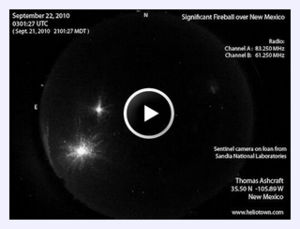
Note: In the still from the movie above, the stationary light is the full Moon, the moving light is the fireball.
Watch a 5 MB movie.
"It took 23 seconds to cross the sky and was nearly as bright
as the full Moon," says Thomas Ashcraft, who operates the camera. "The
fireball made a sonic boom loud enough to be heard inside above fan
noise and household din. At first I thought it was thunder."
After passing over New Mexico, the fireball apparently continued on to
Texas. "At 10:05 pm CDT (9:05 pm MDT) on Sept. 21st we witnessed a
slow-moving fireball entering from the west and headed ENE," reports
Matthew Byrd of Amarillo. "It was very bright white and shedding white
sparks." Remarkably, the first fireball was followed by a second.
"Nearly 7 or 8 min later another was sighted directly over Amarillo
moving the same direction," adds Byrd.
US Space Command reports no satellites or pieces of space junk decaying
at the time of the sightings. This was probably a random meteoroid--and
maybe two--disintegrating in Earth's atmosphere.
Recent multiple fireballs reports streaming in from North and South
America may be linked with the near Earth passing asteroids of Sep 8-9.
The most recent multiple events occurred last night (Sep 21, 2010) over
Texas, New Mexico, and Colorado. The first two of the multiple events
were nearly simultanenous over central New Mexico. They were followed by
Event 3, a 23 second major bolide event over northern New Mexico at
9:03pm MDT (03:03UTC) (see LunarMeteorite Hunters).
Event 4 occurred some one-and-a-half hours later at 10:36pm MDT
(04:36UTC), and was also observed from El Paso, Texas. It was of short
duration, approximately 1.5 seconds, with a visual magnitude of -6. It
followed the identical trajectory of Events 1,2,3 but occurred farther
south, probably over south central New Mexico.
.
Egyptian Desert Expedition Confirms Spectacular Meteorite Impact
ScienceDaily
Thu, 23 Sep 2010 00:00 CDT
A
2008 Google Earth search led to the discovery of Kamil crater, one of
the best-preserved meteorite impact sites ever found. Earlier this year,
a gritty, sand-blown expedition reached the site deep in the Egyptian
desert to collect iron debris and determine the crater's age and
origins.
One day within the last several thousand years, a rare metallic
meteorite travelling over 12 000 km/hour smashed into Earth's surface
near what is today the trackless border region between Egypt, Sudan and
Libya. The impact of the 1.3 m, 10-tonne chunk of iron generated a
fireball and plume that would have been visible over 1000 km away, and
drilled a hole 16 m deep and 45 m wide into the rocky terrain.
Since then, the crater had sat undisturbed by Earth's geologic and
climatic processes, which usually render all but the very largest
terrestrial impact craters invisible. It was also, as far as is
recorded, unseen by humans.
Searching for craters in Google Earth
But that changed in 2008, when the crater was spotted during a Google
Earth study conducted by mineralologist Vincenzo De Michele, then with
the Civico Museo di Storia Naturale in Milan, Italy. He was searching
for natural features, when by chance he saw the rounded impact crater on
his PC screen.
De Michele contacted an astrophysicist, Dr Mario Di Martino, at the INAF
(National Institute for Astrophysics) observatory in Turin, who,
together with Dr Luigi Folco, of Siena's Museo Nazionale dell'Antartide,
organised an expedition to the site in February this year.

Kamil
crater seen by satellite (small round dot near centre of image). A
radar image of the Kamil crater provided by the COSMO-SkyMed satellite
constellation of the Italian Space Agency (ASI 2009) [Click for a larger
image]
It took over a year to plan and obtain
permissions for the journey; in the meantime, and in collaboration with
Telespazio, e-Geos and the Italian space agency ASI, the Kamil region
was analysed using satellite data and in particular high-resolution
radar images provided by the ASI-operated COSMO-SkyMed satellite
constellation.
Expedition to the Egyptian desert
The two-week, 40-person expedition included Egyptian and Italian
scientists, as well as numerous local support workers, and was conducted
as part of the 2009 Italian-Egyptian Year of Science and Technology
(EISY). It was also supported with funding by ESA's Space Situational
Awareness (SSA) programme.
Three-day drive to reach Kamil crater
After a tiring, GPS-guided, three-day drive across the desert in 40°C heat, the team reached the crater.
They collected over 1000 kg of metallic meteorite fragments, including
one 83-kg chunk thought to have split from the main meteorite body
shortly before impact (it was found 200 m away from the crater). The
joint team also conducted a thorough geological and topographical
survey, using ground-penetrating radar to create a 3D digital terrain
model. Geomagnetic and seismic surveys were also carried out.
Ground truth for small-scale impact craters
The researchers were stunned to find that Kamil crater, named after a
nearby rocky outcrop, remains pristine, and must have been created
relatively recently.
"This
demonstrates that metallic meteorites having a mass on the order of 10
tonnes do not break up in the atmosphere, and instead explode when they
reach the ground and produce a crater," says ESA's Dr Detlef Koschny,
Head of Near Earth Objects segment for the SSA programme.
Kamil crater has become the target of intense interest for geologists, astrophysicists and even archaeologists.
"We are still determining the geochronology of the impact site, but the
crater is certainly less than ten thousand years old -- and potentially
less than a few thousand. The impact may even have been observed by
humans, and archaeological investigations at nearby ancient settlements
may help fix the date," says Dr Folco.
The data gathered during the expedition will be very useful to ESA's SSA
activities for risk assessment of small asteroids with orbits that
approach Earth, a category to which the Kamil impactor originally
belonged.
Bob Kobres
Society for Interdisciplinary Studies - Chronology and Catastrophism Workshop
Sun, 26 Jan 1992 00:00 CST
. . . and from heaven a great star shall fall on the dread ocean and
burn up the deep sea, with Babylon itself and the land of Italy, by
reason of which many of the Hebrews perished,
. . . Be afraid, ye Indians and high-hearted Ethiopians: for when
the fiery wheel of the ecliptic(?) . . . and Capricorn . . . and Taurus
among the Twins encircles the mid-heaven, when the Virgin ascending and
the Sun fastening the girdle round his forehead dominates the whole
firmament; there shall be a great conflagration from the sky, falling on
the earth;
Are these lines from Book V of the Sibylline Oracles
eschatological nonsense? Contemporary astronomical evidence suggests a
historic basis for words describing cosmic calamity. British
astronomers, Victor Clube and Bill Napier, in The Cosmic Winter
(1990) and other recent works, provide students of the past with newly
discovered celestial clues which indicate that Earth has been
periodically pelleted with comet fragments throughout the Holocene
period. The evidence for the break-up of a large (> 50 km), short
period (approximately 3.3 years), Earth-orbit-crossing comet is
substantial and should be considered as hard as anything a trowel might
turn up. What astronomical information cannot convey is the actual
effect these periodic bombardment episodes had on human culture; only
further digging and sifting will illuminate that aspect.
Some of what can be uncovered has been buried by prior premise
and so can be brought to light by review of literature published over
the years. For instance, the oracles quoted above are from a 1918 translation of the Sibylline by H.N. Bate. Further into Book V these lines appear:
And then in his anger the immortal God who dwells on high shall hurl
from the sky a fiery bolt on the head of the unholy: and summer shall change to winter that day.
Bate notes that Book VIII contains a parallel passage with winter being
changed to summer--fortunately he did not feel compelled to "correct"
the lines above as others have. For example:
And then the imperishable God who dwells in the sky in anger will
cast a lightning bolt from heaven against the power of the impious. Instead of winter there shall be summer that day.
This comes from Old Testament Pseudepigraphia (vol. 1) published in
1983. Not only has the passage been rationalized (If God throws down
fire it should get hotter, right?), but, a fiery bolt now has become a
lightning bolt.
Evidence of impact induced cold is valuable in gauging how energetic a
past fall was. Based on nuclear winter studies, a cosmic collision would
need to impart at least the energy equivalent of a thousand megatons
TNT into the environment to produce such an effect.
A number of cultures retained stories of impact induced winter. Most
telling of such lore this author has read are these amazingly
informative tales of the Yakuts: [note that the CH in brackets below is
printed in the reference as a "c" with a diacritic "v"]
[CH]OLBON . . . is said to be "the daughter of the Devil and to have
had a tail in the early days". If it approaches the earth, it means
destruction, storm and frost, even in the summer; . . .
[CH]OLBON, the daughter of the Devil is a beautiful girl ... she is
the bride and the sweetheart of Satan's son ÜRGEL (Pleiades). When these
two stars come close to one another, it is a bad omen; their eager
quivering, their discontinuous panting cause great disasters: storms,
blizzards, gales. When they unite, fathom deep snow will fall even in
the summer, and all living beings, men, animals and trees will perish . .
.
Both folk memories were recorded by ethnographer V.L. Serosevsky, the
first in 1877, the next in 1885. The Yakuts identified Venus as colbon;
however, as a later student of this culture, G.V. Ksenofontov, observed:
The Yakuts have two words for the "star": SULUS and [CH]OLBON. The
first means simply "star", the second refers to stars that change their
place in the sky, sometimes appearing and disappearing. Nowadays,
however, it no longer--or very seldom--refers to other planets than
Venus and has almost become its name. Yet, as we have seen, in legends
also other [CH]OLBONS (i.e. planets) are mentioned.
What is remarkable about these particular tales is the conjunction of
several pieces of information. From these lines we gather that a comet
([CH]OLBON with a tail) came close enough to influence weather on
Earth--i.e. deadly storms, frost and deep snow in summer. Also, we are
told that this is most likely to occur if the comet appears close to the
Pleiades. In short, these legends accurately describe what can now be
inferred from astronomical data on comet Encke and the ring of debris
its progenitor strew about the Sun.
As the above example suggests, contemporary researchers need to be wary
of assuming our predecessors' folk memories of astral events relate to
bodies familiar to our time. There is considerable reason to suspect
that the majority of the planets namesakes were comets--probably of the
Encke family.
A conventional view comes from W.M. O'Neil's Time and the Calendars (1975):
The word planet comes from the Greek PLANETES, the wanderers; these
seven celestial bodies moved among the fixed stars. The Babylonians had a
more picturesque name, BIBBU, the wild sheep, as these bodies broke
through the fixed formation in which the tame sheep crossed the sky.
To call into question Greek continuity of planet identity I refer to
Leonardo Taran's work on the "Pseudo-Platonic" Epinomis (1975) where in
commentary on lines 986 A 8-987 D 2, Taran states:
Having previously proved to his own satisfaction that all the
heavenly bodies are the greatest divine living beings and having pointed
out that they are not yet honored as gods, the author explains who
these visible gods are and why they are not honored in Greece. They are
the eight interrelated sidereal revolutions and the heavenly bodies
which travel on them, for they are all gods of the same kind. And the
contemplation of this divine cosmic order is what will make a man happy
both in this life and in the next. But the lack of this wisdom in Greece
is due to ignorance of the true paths of the planets, a knowledge which
comes from the Orient and which must be incorporated into our laws.
That the knowledge of the planets comes from the Orient is to be seen in
the very fact that the planets lack proper names and are called after
the (traditional) gods, for this kind of appellation is due to the
barbarians who first discovered the planets.
The Epinomis, which dates from around the 4th century BCE, is the
earliest extant record of Greek planet names; each is given as "the star
of": Cronos, Zeus, Aphrodite, etc. Clearly the planets did not inspire
the earlier stories which championed these gods. The mythology
associated with these names certainly better describes the break-up of a
comet with an orbit that crossed Earth's path than the monotonous
behavior of planets.
As for the BIBBUS, as well as the Oriental influence alluded to above I call attention to J.K. Bjorkman's article in Meteoritics (1973) which deals with much earlier texts:
We move now to a discussion of a word which probably refers to
comets, BIBBU. . . BIBBU has a variety of astromantic and
non-astromantic meanings. There is a lengthy omen text, the 56th tablet
of Enuma Anu Enlil, which deals with various features of the BIBBU, and
some of these seem to describe comets. For example:
If a BIBBU continues one day, two days in the sky and does not disappear:
If three or four BIBBUS rise one after the other at sunrise
The latter text might refer to a comet which has broken up into three or four comets . . . .
There are many more references to BIBBU, but in them the translations "unspecified planet" or "meteor" could be proposed.
Confusion of planet terminology is also evident further to the east as
can be demonstrated by James Legge's translation of a passage concerning
the emperor Kwei in the Annals of the Bamboo Books:
In his 10th year, the five planets went out of their courses. In the
night, stars fell like rain. The earth shook. The E and Loh became dry.
With astronomical evidence in mind a simplified, but testable, hypothesis of Bronze Age collapse would involve accepting the legend of Phaethon as an event inspired myth, as Plato contended it was, and also giving credence to stories of protracted winter in the aftermath of celestial "battles," such as the Ragnarok.
During a close approach to a massive object like our planet a comet
would be gravitationally disrupted (Phaethon's disentegrating chariot)
independent fragments would then further break to pieces as they entered
Earth's atmosphere. This debris, of various shapes and sizes, would
scatter widely along the path of the fall, each piece harboring energy
in proportion to its mass. The "footprint" of this event could have
included some of: southern Europe, the Mediterranean, the Near East, and
Northern Africa. Damage, however, would not be uniform throughout this
area. If the disintegrating objects were traveling south of east, as the
Phaethon story implies, the more massive fragments would travel farther
and release their greater energy, explosively, lower in the atmosphere
toward the southeast end of the elliptical area directly affected by the
fall. In other words, the Near East would be more heavily damaged than
southern Europe. A survey scaling intensity of site destruction might
reflect this aspect, i.e., vitrification of soil and building materials
might occur below lower altitude multi-megaton blasts.
Secondary effects of a large impact event would include: a spottily
enhanced C-14 environment, making this means of dating unreliable to
confirm or refute simultaneous destruction of disparate sites; a large
production of oxides of nitrogen yielding dangerous ozone depletion,
perhaps giving a survival advantage to darker skinned people in the
aftermath, particularly in equatorial regions; acidic precipitation from
the above-mentioned atmospheric chemistry; and, in the higher
latitudes, impact winter, caused by suspended dust and soot.
All of these phenomena would leave evidence which careful field work
could reveal. Some indicators may already be evident, such as the
abandonment of many long settled sites, a large southward movement of
people from the higher latitudes, and a steep, long-term (1159-1140 B.C.) decline in the annual growth of Irish bog oak that stands out in the 7,272 year long dendrochronological record, based on this species of tree. [Baillie and Munro (1988)]
Definitive evidence of impact, however, can only come from a detailed analysis of debris directly overlying destruction sites.
I urge archaeologists working on this time period to diligently collect
dust and debris from cracks and crevices where violent destruction is
apparent. In 1992 the current Greenland ice coring project should be
complete. If a large impact occurred around 3200 years ago a significant
nitric acid spike will be evident in these ice core samples. Several
cores are being drilled simultaneously, so the chance of finding debris
in association with the nitric acid signal should be good. An element
profile on this material could then be compared with results on debris
extracted from terminal Bronze Age sites. If these match, not only will
there be confirmation of a violent natural catastrophe, we will also
have gained a rather precise gauge of when the disaster took place.
Astronomical evidence indicates our ancestors viewed a much more active
sky than we. A seemingly nonsensical notion, such as Athena being born
fully formed from the head of Zeus, becomes understandable as a
description of comet fragmentation. Human belief systems have been
greatly influenced by the phenomena attending the progressive break-up,
over thousands of years, of this large comet. The idea of a wrathful sky
god or star positions influencing events on Earth are legacies of this
influence.
Many astronomers believe the 1908 Tunguska impact
was from a small piece of Comet Encke. This 15 to 30 megaton event
leveled 2000 sq km of dense Siberian forest, but left no crater.
Certainly there have been many damaging falls witnessed by people during
the 15,000, or more, year period of the comet's fragmentation history.
The terminal Bronze Age event was probably just one of several very
energetic impacts which likely occurred in this time span.
Our less than seven hour separation from a collision with a near-Earth asteroid (1989FC)
in March of 1989 underscores the fact that contemporary civilization
could be thrown into a dark age by natural catastrophe. Had 1989FC
encountered Earth it would have introduced the energy equivalent of more
than 2,000 megatons TNT into the environment, with little or no
warning. The object was discovered on photographs days after the close
pass. In 1937 an even larger object, Hermes, came almost equally near
Earth. Neither of these asteroids is likely to be related to the
break-up of the recent large comet referred to above. The estimated
population of Earth-orbit-crossing objects greater than half a kilometer
in diameter is over 2,000 and its members are from various sources.
Obviously our planet gets hit fairly often. What the recent large comet
did was increase the likelihood of collision and establish a visible
cause/effect relationship in the minds of our ancestors.
The association of disaster (etymologically, dis - evil; aster - star)
with comets eventually became generalized beyond direct causal links,
giving science oriented investigators reason to classify this ubiquitous
notion as mere superstition. Scientific efforts to understand the past
were thus rendered purblind to a highly influential natural phenomenon.
It is technically feasible to prevent future impacts by altering the
orbits of threatening objects. Unfortunately, there is little widespread
support for such an Earth Defence Initiative (EDI) due, in part, to the
general belief that humanity has not, in the past, been harmed by
impact events.
Archaeologists can play a key role in justifying an EDI by digging in to set the record straight.
Though gaining a detailed understanding of the effects such episodic
impacts had on humanity will take some time, incorporating recent
astronomical evidence can provide immediate boons to our comprehension
of past cultures.
The fortunate find in the seventies, at Mawangdui, China, of a Han
dynasty silk comet atlas sheds considerable light on earlier enigmatic
motifs. Most illuminating is the drawing, described by text on the
artifact as a long-tailed pheasant star. This rendering of a jetting
comet viewed down its axis of rotation has a considerable history,
and, as a motif, appears on artifacts found in most areas of the world.
The artist who illustrated this silk twenty-two hundred, or so, years
ago was not likely a first-hand observer. What is produced here is a
schematic of received comet caricatures with claims that specific things
will happen if a represented type appears. The pinwheel-like image is
unique to the compilation in that an omen is given for an appearance in
each of the four seasons, implying that this comet was seen more often
than the others represented. This may illustrate a frequently viewed
aspect of comet Encke which has a 3.3 year orbit and rotational axis
that occasionally points toward Earth. [Whipple, F. 1985]
Important in understanding ancient oriental lore is learning that
this motif was associated with the pheasant (divine bird in China) which
is frequently mentioned in the Chinese classics. The link between the
spinning cross and birds is evident on artifacts from many cultures.
Perhaps the association of the Sanskrit term "svastika" with this symbol
can be linked to the Astika Parva in the Mahabharata which
relates the birth of a cosmic bird par excellence--Garuda. This fabulous
winged deity had a radiance like the Sun, could change shapes at will,
and destroyed other gods and kings by casting down fire and stirring up
storms of reddish dust which darkened the Sun, Moon and stars. Clearly
Garuda was symbolic of an Earth approaching comet.
The bird-comet connection is even more obvious in the Jamva-khanda Nirmana Parva of the Mahabharata
which describes a fierce fowl with but one wing, one eye, and one leg,
hovering in the night sky. As this bird "screams" and "vomits blood":
All the quarters of the earth, being overwhelmed by showers of dust,
look inauspicious. Fierce clouds, portentous of danger, drop bloody
showers during the night. Rahu of fierce deeds is also, O monarch,
afflicting the constellation Kirtika. Rough winds, portending fierce
danger, are constantly blowing.
The mention of Rahu, the demon of eclipse, which originally had four arms and a tail that was severed by Vishnu to become Ketu (comet)
is interesting in that the demon is here darkening Kirttika (the
Pleiades) in the month of Karttika (latter half of October, through mid
November), for the tale goes on to relate that:
. . . in course of the same month both the Moon and the Sun have
undergone eclipses on the thirteenth days from the day of the first
lunation. The Sun and the Moon therefore, by undergoing eclipses on
unusual days, will cause a great slaughter of the creatures of the
earth. Meteors, effulgent like Indra's thunder-bolt, fall with loud
hisses . . . People, for meeting together, coming out of their houses
with lighted brands, have still to encounter a thick gloom all round . .
. From the mountains of Kailasa and Mandara and Himavat thousands of
explosions are heard and thousands of summits are tumbling down . . .
Fierce winds charged with pointed pebbles are blowing, crushing mighty
trees. In villages and towns trees, ordinary and sacred, are falling
down, crushed by mighty winds and struck by lightning.
This is, without doubt, a mythological record of an intense meteor storm
from the still active Taurid stream which presently peaks around the
first of November and appears to radiate from near the Pleiades star
cluster. The un-airworthy bird associated with this meteor bombardment
could have been comet Encke which until recently was thought to be the
sole source for the Taurid meteors. However, the discovery of other
large contributors which are now dark but were once active comets rules
out a positive identification.
In a less artificial environ animal tracks speak strongly to people and
convey much about the creature which left them. Thus a bear, bird or any
animal which made impressions on the ground could be symbolically
represented in total by drawing these marks. I suggest that the jetting
comet, to some cultures, looked like a bird's foot and, as a motif,
represented a divine fowl. This can explain why the not very bird-like
drawing on the Han silk is captioned as a pheasant star. Chinese lore
upholds such an interpretation as Ts'ang Chieh, the four eyed legendary
inventor of writing, derived his inspiration to create written symbols
from noticing the marks of birds' feet in the sand. His ancient style is
known as niao chiwen--"bird foot-prints writing." [MacCulloch, C.J.A.
1928]
Symbolic
bird tracks, unrecognized as such, appear on objects unearthed by
Heinrich Schliemann from Hissarlik in Asia Minor. Artifactual support
for this contention comes from petroglyphs found in the south-western
United States which Pueblo people identify as roadrunner (a type of
cuckoo) tracks and identical renderings found by Schliemann. [Morphy, H. 1989] The close association of these two distinctive crosses on artifacts from Schliemann's Troy
could be considered coincidental and not necessarily avion-inspired
were they found out of context, however, in Schliemann's words:
In treating now of the various kinds of potteryof this third city, I
begin with the owl-faced idols and vases, and I would repeatedly call
very particular attention to the fact, that the idols, of which I
collected about 700, are all of the same shape; that they represent in
the rudest possible outlines a female form; and that, therefore, they
cannot but be copies of the ancient Palladium, which was fabled to have
fallen from heaven with joined feet.
Owls, like cuckoos, have zygodactylous or semizygodactylous (outer
toe reversible) feet. Obviously these "Trojans" had an elaborate belief
system which focused on the activities of a non-terrestrial bird of the
night. With this in mind, a re-examination of artifacts recovered from
Hissarlik could be quite revealing.
Another aspect of comets which is evident in ancient lore involves shape shifting.
A comet is three dimensional and could appear as quite a different
animal when viewed from a different angle. For instance, allowing that a
foot-print signifies the creature, the fabled ability of Yu (mentioned above)
to transform into a pheasant or bear can be easily understood as a
radial view distinguished from an axial view of the same comet.
Comets can also change spontaneously; a gas emitting area could become
dust covered and extinguish a jet, a piece of the comet could break
away, creating another comet, perhaps initially more flamboyant than its
parent. Our ancestors' stories speak of these weakening gods and
fantastic births; however, until now, our ears heard only gibberish.
Another motif which is found around the world is the concentric circle.
Astronomers, with the aid of a telescope, have reported, and drawn
pictures of, comets which exhibit concentric rings, so it is likely that
some of these ancient renderings, often pecked in stone, represent
comets. There is, however, probably another phenomenon more often
represented by these ancient bull's-eyes--a bolide storm.
Fred Whipple, the astronomer who theorized in 1950 the now proven
structure of comets, calculates that the night time Taurids have been a
feature for 5,000 years. It now takes Earth about three months
(mid-September to mid-December) to traverse this band of debris. Earlier
in its history, as the progenitor of comet Encke was creating it, this
debris ring had to have been more dense. As Earth passed through the
mess, it no doubt collected a considerable amount of dust. The night
time Taurids are known for frequent bolide activity. Large, vaporizing
meteoroids (bolides) in an atmosphere loaded with comet dust will
produce unusual visual effects. Refraction, reflection, and possibly
secondary emission come into play as a sizable object splashes into an
aerosol laden atmosphere compressing molecules of gas against motes of
dust in its bow-shock wave until--BOOM
-- the object vaporizes, illuminating the multiple layers of
compression separated gas and debris. From the ground this might look as
if a god threw a pebble in the sky pond. Quite likely a large sector of
the sky would be filled with such phenomena. Though the intensity would
vary from year to year our ancestors, no doubt, expected a rather
disconcerting light show on an annual basis.
Striking evidence for this contention comes from well-preserved
Neolithic observatories in Ireland. Martin Brennan (1983), who spent
over a decade investigating these structures, published a wonderful
documentation of their features. Though he assumes them to be a product
of solar worship, his research is thorough and includes mythological
references to these megalithic works--most intriguing from the
standpoint of this discussion is Tara. Brennan states that:
Tara lies 10 miles southwest of Newgrange and, like Newgrange, it is
steeped in ancient myth and tradition. It has always been associated
with Samhain, the Celtic observance of the year's turning in November,
and this event is well documented. Mythologically, the mound also has
associations with the Tuatha De Danann, or the "Lords of Light." They
arrive from the air and cast a darkness over the sun for three days.
This neolithic observatory is aligned, according to Brennan, to
cross-quarter days November 8 and February 4. The carved stone within
this megalithic structure depicts concentric circles similar to the
earth works evident in the aerial photograph of Tara shown.
Incorporating astronomical evidence of a recent giant short
period comet into our attempt to understand past cultures is essential
for an objective interpretation.
Bibliography
Armstrong, Edward A. (Ed.) The Folklore of Birds. Dover Publications, Inc. NY, 1970.
Baillie, M.G.L. & Munro, M.A.R. "Irish tree rings, Santorini and volcanic dust veils." Nature vol. 332 24 March 1988 (pp. 344-346).
Barnard, Noel (Ed.) Early Chinese Art and its Possible Influence in the Pacific Basin. vol. 1 Intercultural Arts Press, NY, 1972 (pp. 118-121, 150-151).
Barnard, Noel. The Chu Silk Manuscript (Translation and Commentary, part 2) Australian National
University, Canberra, 1973 (pp. 122-156).
Bate, H.N. The Sybilline Oracles Books III-V MacMillan Company, NY 1918 (p.107).
Bjorkman, J.K., "Meteor and Meteorites in the Ancient Near East" METEORITICS 1973 vol. 8, (pp. 91-132).
Brennan, Martin. The Stars and The Stones. Thames and Hudson Inc., NY 1984 (pp. 14-15, 120-121).
Charlesworth, James H. Old Testament Pseudepigraphia (vol 1) Doubleday, Garden City, NY 1983 (p. 400).
Clube, Victor and Napier, Bill. The Cosmic Winter. Basil Blackwell, Inc. Cambridge MA 1990.
Dioszegi, V. Popular Beliefs and Folklore Traditions in Serbia (English translation by Dunn, S.P.) Indiana University,Bloomington, 1968 (pp. 485-496).
Kobres, Bob. "Meteor Defense" Whole Earth Review No. 56 Fall 1987 (pp. 70-73).
Legge, James. The Chinese Classics (vol. 3) Hong Kong Univ.Press, Hong King 1960 (p. 125).
Lonsdale, Steven. Animals and The Origins of Dance, Thames and Hudson Inc., NY, 1982 (pp. 169-181).
MacCulloch, C.J.A. Canon, John A. (Ed.) Mythology of All Races. vol. 8 ("Chinese Mythology" Ferguson, John C.) Marshall Jones Co. Boston, MA 1928 (p. 31).
Morphy, Howard (Ed.). "Animals into Art" (One World Archeology; vol. 7) Unwin Gyman Ltd., London, 1989 (chapt. 11 Schaafsma, Polly).
O'Neil, W.M. Time and the Calendars. Sydney Univ. Press, Sydney 1975.
Roy, Pratap Chandra. The Mahabharata, Munshiram Manoharlal, New Delhi, 1973 (vol. 1 section 13-58, vol. 5 section 2-3)
Schliemann, Henry. ILIOS Harper & Brothers, Franklin Square, NY, 1881 (pp. 334-353).
Taran, Leonardo. Academica: Plato, Philip of Opus, and the Pseudo-Platonic Epinomis, American Philosophical Society, Philadelphia, PA, 1975 (p. 294).
Whipple, Fred L. The Mystery of Comets, Smithsonian Inst. Press, Washington, DC 1985, (pp. 163-167).
Louise Good
University of Hawaii at Manoa
Tue, 28 Sep 2010 08:26 CDT

Two
images of 2010 ST3 (circled in green) taken by PS1 on the night of
Sept. 16 show the asteroid moving against the background field of stars
and galaxies.
The University of Hawaii' at Mānoa's
Pan-STARRS PS1 telescope on Haleakala has discovered an asteroid that
will come within 4 million miles of Earth in mid-October. The object is
about 150 feet in diameter and was discovered in images acquired on
September 16, when it was about 20 million miles away. It is the first
"potentially hazardous object" (PHO) to be discovered by the Pan-STARRS
survey and has been given the designation "2010 ST3."
"Although this particular object won't hit Earth in the immediate
future, its discovery shows that Pan-STARRS is now the most sensitive
system dedicated to discovering potentially dangerous asteroids," said
Dr. Robert Jedicke, a University of Hawaii at Mānoa member of the PS1
Scientific Consortium (PS1SC), who is working on the asteroid data from
the telescope. "This object was discovered when it was too far away to
be detected by other asteroid surveys," Jedicke noted.
Most of the largest PHOs have already been catalogued, but
scientists suspect that there are many more under a mile across that
have not yet been discovered. These could cause devastation on a
regional scale if they ever hit our planet. Such impacts are estimated
to occur once every few thousand years.
Objects the size of 2010 ST3 usually break up in Earth's atmosphere, but
the resulting blast wave on the surface can still devastate an area
covering hundreds of square miles. "There is a very slight possibility
that ST3 will hit Earth in 2098, so it is definitely worth watching,"
Jedicke said.
Dr. Timothy Spahr, director of the Minor Planet Center (MPC), said, "I
congratulate the Pan-STARRS project on this discovery. It is proof that
the PS1 telescope, with its Gigapixel Camera and its sophisticated
computerized system for detecting moving objects, is capable of finding
potentially dangerous objects that no one else has found." The MPC,
located in Cambridge, Mass., was established by the International
Astronomical Union in 1947 to collect and disseminate positional
measurements for asteroids and comets, to confirm their discoveries, and
to give them preliminary designations.
Pan-STARRS expects to discover tens of thousands of new asteroids every
year with sufficient precision to accurately calculate their orbits
around the sun. Any sizable object that looks like it may come close to
Earth within the next 50 years or so will be labeled "potentially
hazardous" and carefully monitored. NASA experts believe that, given
several years warning, it should be possible to organize a space mission
to deflect any asteroid that is discovered to be on a collision course
with Earth.
Pan-STARRS has broader goals as well. PS1 and its bigger brother, PS4,
which will be operational later in this decade, are expected to discover
a million or more asteroids in total, as well as more distant targets
such as variable stars, supernovas, and mysterious bursts from galaxies
across more than half the universe.
The PS1 surveys have been made possible through contributions of the PS1 Science Consortium:
the University of Hawaii at Mānoa Institute for Astronomy; the
Pan-STARRS Project Office; the Max-Planck Society and its participating
institutes, the Max Planck Institute for Astronomy, Heidelberg and the
Max Planck Institute for Extraterrestrial Physics, Garching; the Johns
Hopkins University; Durham University; the University of Edinburgh; the
Queen's University Belfast; the Harvard-Smithsonian Center for
Astrophysics; the Las Cumbres Observatory Global Telescope Network,
Inc.; and the National Central University of Taiwan. Construction
funding for Pan-STARRS (short for Panoramic Survey Telescope & Rapid
Response System) has been provided by the U.S. Air Force Research
Laboratory.
What Happened In Chandler?
CBS 5 News has crews working to find out what caused the loud booms reported by dozens of Chandler residents Sunday night.
On this Google map, 40 entries have been made pinpointing locations and times of the loud booms.
From the entries, it appears the booms happened Sunday around 6:30 p.m., 9:00 p.m. and midnight in the area of Dobson and Frye.
In each of the entries, people briefly explained what they experienced:
"Felt like blasting in a mining town."
"My husband and I were in different areas of our house and heard the
first boom. We were afraid something had hit our house and ran outside
to find out what was going on but could not find or see anything. My
husband then heard 2 more loud booms throughout the evening."
"First boom was loud and I felt the ground move. Second boom was not
as loud and I felt no movement. Biggest boom was right before 9 p.m.
and it rattled the walls in my house and sounded like a huge explosion.
Definitely something going on!"
"Sounded like a cannon from the southeast"
"I met several neighbours outside after the boom trying to figure
out what it was. It sounded like something hit the roof. The other
neighbours seemed to have experienced the same thing."
"We heard and felt three hard jolts Sunday evening between 6 and 9
o'clock. We thought at first that it was our air conditioner. Two
neighbours to our east and two neighbours to our west also heard and
felt the jolts."
"One loud boom probably at 6:30..shook the house and my dogs
freaked!! Thought an explosion, sonic boom or something hitting a house.
Very surprised to see nothing on the news. It was BIG."
CBS 5 News spent all day Monday and Tuesday trying to get to the bottom
of this mystery. There was an earthquake in Baja, California. on Sunday.
However, the quake struck before the booms. Also, neighbours said their
pool water stayed still, which didn't happen in past quakes.
Luke Air Force Base said they don't fly on Sunday and never fly in that area.
CBS 5 News also checked with Chandler Airport and Williams Gateway
Airport. Both airports said they don't have jets that can fly at super
sonic speeds.
Chandler police and fire departments have both looked into the noises and have no clue what caused them.
CBS 5 News checked with the City of Chandler's Waste Water Department and Public Works Department. Both reported no problems.
Crews will keep digging until they get answers.
Marshall
Space Flight Center PAO Steve Roy was out jogging early Friday morning
with his dogs, Lilly and Scout, when he couldn't help but notice this
bright meteor low in the eastern sky.
Also seen by NASA's all sky meteor cameras at MSFC and in Chickamauga,
GA, the meteor was located above the Atlanta area, some 180 miles away
from where he was running.
Moving at 97,500 miles per hour, it disintegrated in a flash of
light 45 miles above the ground. You can watch the meteor as captured
by the cameras at the Marshall Space Flight Center:
and also as seen by the camera at Chickamauga:
I filmed this off the deck of our work vessel . We were at anchor in
the Reo harbor in Brazil on the 22nd of September about 9:30 PM. We
were looking north close to the flight path of the Reo air port. There
was more but this is all I filmed.It seemed to be stationary in the sky,
by that I mean it didn't seem to be moving across the sky. One of the
crew was looking at it with binoculars and commented on the fact that
it appeared to go back up until it disappeared out of site I don't know
what it was. It lasted about 20 minutes.
More clips below:

A
pale green interloper among the stars of Cassiopeia, Comet Hartley 2
shines in this four-minute exposure taken on the night of Sept. 28,
2010, by NASA astronomer Bill Cooke.
Still too faint
to be seen with the unaided eye, the comet was 18 million miles away
from Earth at the time. Cooke took this image using a telescope located
near Mayhill, N.M., which he controlled via the Internet from his home
computer in Huntsville, Ala.
Comet-watching from the comfort of your living room? Modern astronomy is truly amazing...
Comet 103P/Hartley 2, a small periodic comet, was discovered in 1986 by
Malcolm Hartley, an Australian astronomer. It orbits the sun about every
6.5 years, and on Oct. 20, the comet will make its closest approach to
Earth since its discovery.
In this case, "close" means 11 million miles, or 17.7 million
kilometers. A moonless sky will make for promising viewing conditions in
the northeastern skies, especially just before dawn.
View larger image here.
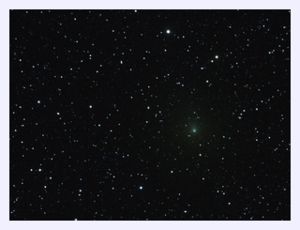
Comet Hartley 2 approaches Earth at a distance of 18 million miles, seen on Sept. 28, 2010.
A
pale green interloper among the stars of Cassiopeia, Comet Hartley 2
shines in this four-minute exposure taken on the night of Sept. 28,
2010, by NASA astronomer Bill Cooke. Still too faint to be seen with the
unaided eye, the comet was 18 million miles away from Earth at the
time. Cooke took this image using a telescope located near Mayhill,
N.M., which he controlled via the Internet from his home computer in
Huntsville, Ala. Comet-watching from the comfort of your living room?
Modern astronomy is truly amazing...
Comet 103P/Hartley 2, a small periodic comet, was discovered in 1986 by
Malcolm Hartley, an Australian astronomer. It orbits the sun about every
6.5 years, and on Oct. 20, the comet will make its closest approach to
Earth since its discovery. In this case, "close" means 11 million miles,
or 17.7 million kilometers. A moonless sky will make for promising
viewing conditions in the northeastern skies, especially just before
dawn.
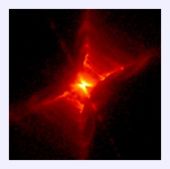



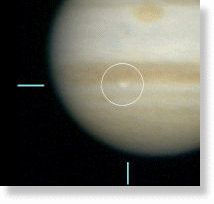

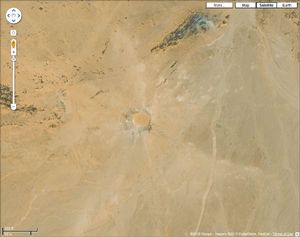
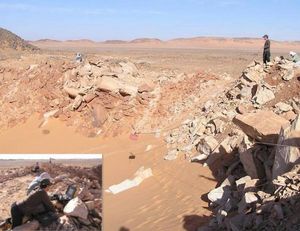

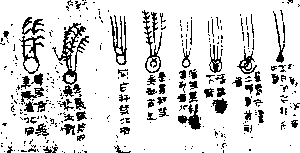


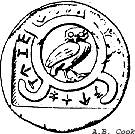
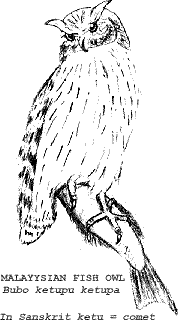
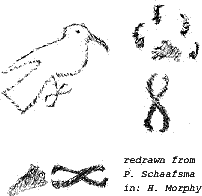
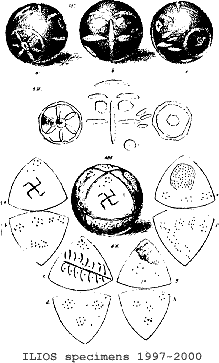


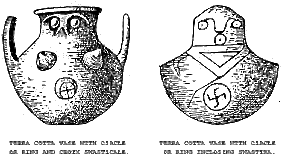
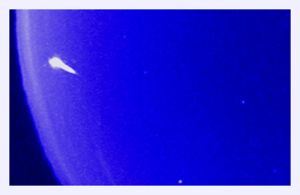
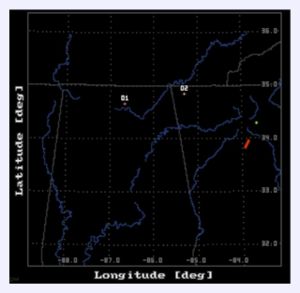
No comments:
Post a Comment